Introduction
Colombia is considered a mega-diverse country due to its great variability of ecosystems and geography, which has resulted in a wide range of life forms product of diversification caused by the evolutionary processes occurring in the national territory (Kattan and Franco 2004; Rodríguez- Mahecha et al. 2006). This richness is reflected in most groups, where specifically for mammals, Colombia has recorded to date at least 518 species (Solari et al. 2013; Ramírez-Chaves et al. 2016), but with a very high potential of a considerable higher number.
Previous analyses of mammal diversity in the country have identified the Andean region as the one with the highest number of species, followed by the Amazon and the Pacific regions (Solari et al. 2013). The most plausible reason of this high diversity is the branching of this mountain range in the country, generating a large number of micro-climates and conditions that have led to a significant number of biomes and ecosystems, which in exchange impacted many species' diversification processes (Prado and Bonilla 2009). However, despite this remarkable diversity, the region has received limited research attention, with considerable gaps on many ecological aspects of the group, including the conservation status of many species, especially for medium- and large-sized species (Sánchez et al. 2004; Ramírez and Pérez 2006; Ramírez-Chaves and Noguera-Urbano 2010; Ramírez-Chaves et al. 2013). To date, most research has centered mainly on small mammals, bats, and/or single species studies (Sánchez et al. 2004; Prado and Bonilla 2009; Rodríguez-Posada 2010), still with many ecological and conservation questions pending regarding the other groups.
For Colombia, most of the research in the Andes has focused mainly in a few regions (i. e., Cauca, Nariño, Cundinamarca, Caldas and Antioquia departments; Castaño et al. 2003; Sánchez et al. 2004; Ramírez-Chaves and Noguera-Urbano 2010; Solari et al. 2013), with a significant portion of the range still mostly unknown for most groups (i. e., Santander, Norte de Santander and Boyacá). Unfortunately, these unknown regions are also suffering accelerated landscape transformation, and historically, the growth and expansion of human settlements has also cause an increase in the number of threatened species (Armenteras et al. 2003; Forero-Medina and Joppa 2010). Moreover, among the least known regions, the Northeast of the Andean mountain range has received the lowest research attention historically (Caceres-Martinez and Acevedo 2014). For this specific region, information regarding species richness, ecology and conservation status, especially for medium and large-sized mammals, is almost inexistent, even within protected areas (Castaño et al. 2003; Ramírez-Chaves et al. 2016; Ramírez-Chaves and Noguera-Urbano 2010; Caceres-Martinez and Acevedo 2014), mostly caused by social and violence problems historically operating in the region.
Norte de Santander Department, located in the Northeast region of the Andes mountain, includes three protected areas, considered among the most valuable within the National Protected Areas System: Catatumbo-Bari National Natural Park (NNP), Estoraques NNP, and Tamá NNP. For these areas, no information existed regarding mammal diversity until our recent research efforts conducted in Tamá NNP (Caceres-Martinez and Acevedo 2014; Cáceres-Martínez et al. 2015), although some information available on gray literature for the same area is available (i.e., thesis and technical reports). In order to support conservation strategies for mammals locally and regionally, generating basic information for the region has become a critical need, especially for these protected areas (Ceballos and Brown 1995; O'Brien 2008; Tobler et al. 2008). We report in this study the first assessment of medium- and large-sized mammals' diversity for Tamá NNP and its buffer zones as support for adequate protected area management and as basis for the potential expansion of the park.
Materials and methods
Study area. The study was conducted in Tamá NNP and buffer zones (La Carpa and La Rochela areas; 7° 14' 36" N, -72° 13' 19" W, WGS84), in the Department of Norte de Santander, in the northern most extreme of the Colombian Andes mountain range on the border with Venezuela. With an elevation gradient ranging from 350 to 3,500 m (Setina et al. 2012), Tamá NNP and its buffer zone has an approximate area of 53,000 ha (48,000 ha of official park) and is composed mostly of Andean and Sub-Andean forests (36.6 and 27.9 %, respectively), Tropical forests (18.8 %), and a lower proportion of cloud forests (7.8 %) and Páramo (8.9 %; Holdridge 1987; Minambiente 2008). These protected areas comprise the entire Tamá massif, commonly known as the Tamá Binational Park (Minambiente 2008). The most significant threats to the area include deforestation on the buffer areas and a significant pressure from hunting (Caceres-Martinez and Acevedo 2014; Cáceres-Martínez et al. 2015). More recently, La Carpa and La Rochela, two areas located in the buffer zone, were assigned for management under the NNP administration, but are not currently officially included in the park boundaries; we also included sites in these areas in order to provide baseline data for its potential inclusion in the protected area.
Methods
Our sampling design included 24 quadrants of 9 km2 that were surveyed between June 2012 and May 2015 (Figure 1) covering an area of approximately 216 km2 and an elevation range between 1,843 and 3,445 m. We used four complementary methods: camera traps, transects, opportunistic observations and interviews.
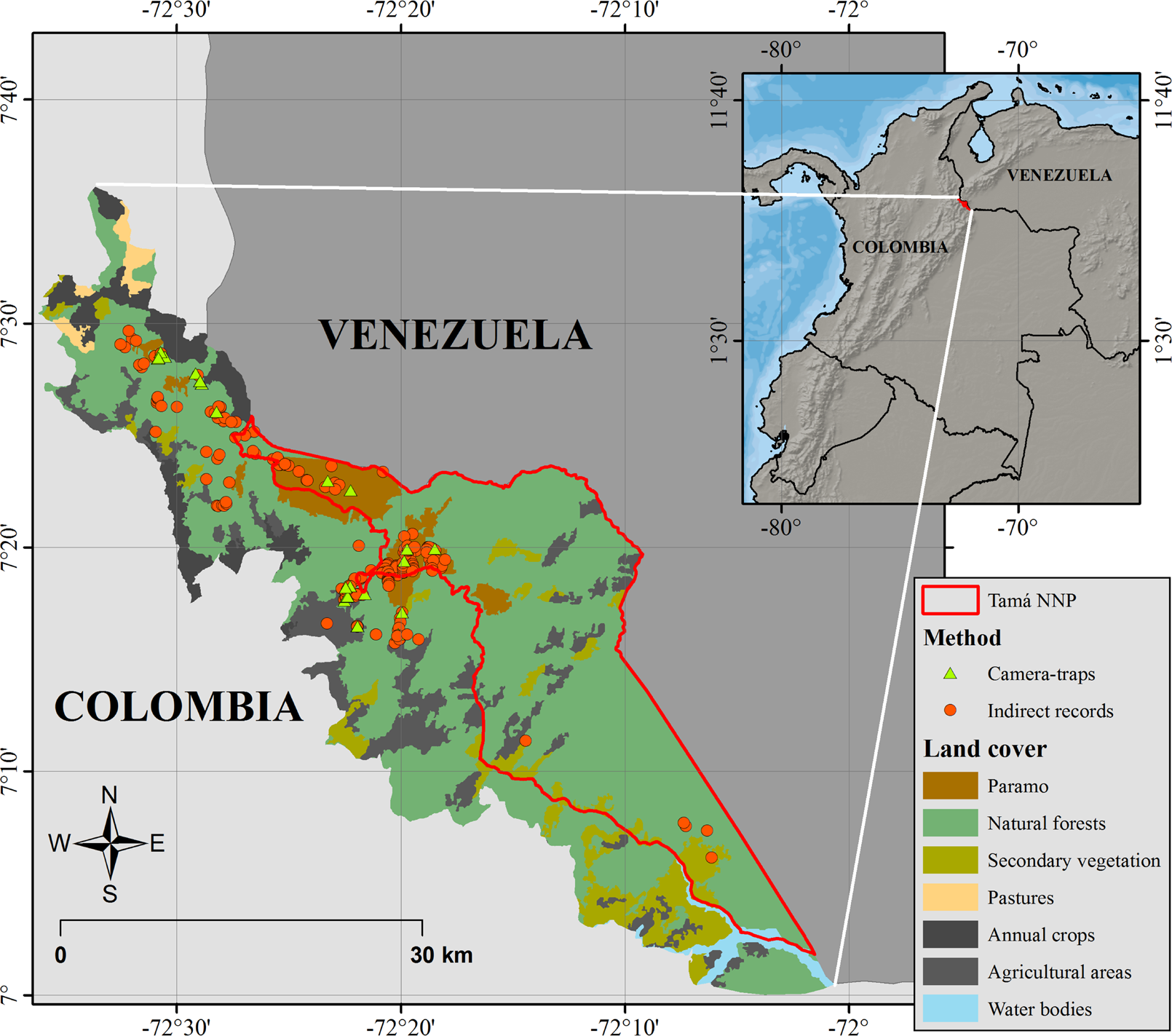
Figure 1 Geographic location of Tamá National Natural Park and its buffer zone and location of Camera-traps and Indirect records where medium and large-sized terrestrial mammals̕ records were obtained.
Surveys with camera-traps (Reconyx RM45, Reconyx HC500, Bushnell Trophy Cam, and Primos Truth Cam 35) included 58 single-camera stations and three paired-camera stations for a total sampling effort of 16,714 camera-trap days. Camera trap stations were separated approximately 1 km depending on the terrain, without any preset spatial pattern. Stations were selected by identifying random sites within the grid with signs of the presence of medium- and large-sized mammals (Goldstein et al. 2013). Capture rates were estimated as the number of detections of a species relative to the total number of detections, scaled to 100 trap-nights (Mosquera-Muñoz et al. 2014). Activity patterns were described for species with enough independent detections (González-Maya et al. 2009); Kuiper tests (K) were used to assess the homogeneity across 24-hour day periods for the entire assemblage and for each species (González-Maya et al. 2015). All species were classified according to the predominant activity period in Diurnal (06h00 to 18h00), Nocturnal (18h00 to 06h00) and Cathemeral (activity on both periods; González-Maya et al. 2009). Contingency tables and Morisita-Horn index were used to test overlapping among activity periods for all species.
Transect sampling included three 1.8 km transects on each quadrant (a total of 72 transects), surveyed between 8:00 and 18:00 h during the total sampling period, comprising an effort of 190 days (i. e., 1,900 man-hours), and accounting for direct observation and tracks and signs such as feces, hair, tracks, corpses and/or skeletal remains, foraging activity, trails, marking sites and dens/burrows (Guzmán-Lenis and Camargo-Sanabria 2004). For each detection we recorded a description of the site, type of evidence, location, photographic record and elevation. Hair, feces, and skeletal remains were stored in labeled plastic bags before processing and identification in the laboratory of Ecology and Biogeography (GIEB), University of Pamplona. Samples processing included washing with distilled water on strainers of 0.5 μm, drying at room temperature, and visual examination of sample components. Samples were compared with reference material from the mammal collection of the Institute of Natural Sciences of the National University and the Museum of Sciences "José Celestino Mutis" of the University of Pamplona and deposited in the general mammal collection at the latter museum. Opportunistic observations were obtained during fieldwork, and include those that were not specifically located on a specific transect.
Interview surveys were conducted with communities in 13 localities of the area, obtaining a total of 39 interviews of independent family settlements. Interviews were constructed following a semi-structured open-ended questions structure, trying to account for an interpretive and participatory approach (White et al. 2005). Interviews were supported with camera trap and field- guide photos and illustrations (Emmons and Feer 1997; Ceballos and Oliva 2005; Aranda 2012). For all interviews we asked the interviewed person for evidence in order to obtain supporting material for all records (Figure 3, Table 1). We based our field identification on field guides (Emmons and Feer 1997; Ceballos and Oliva 2005; Aranda 2012) and followed Wilson and Reeder (2005) for general taxonomic classification.
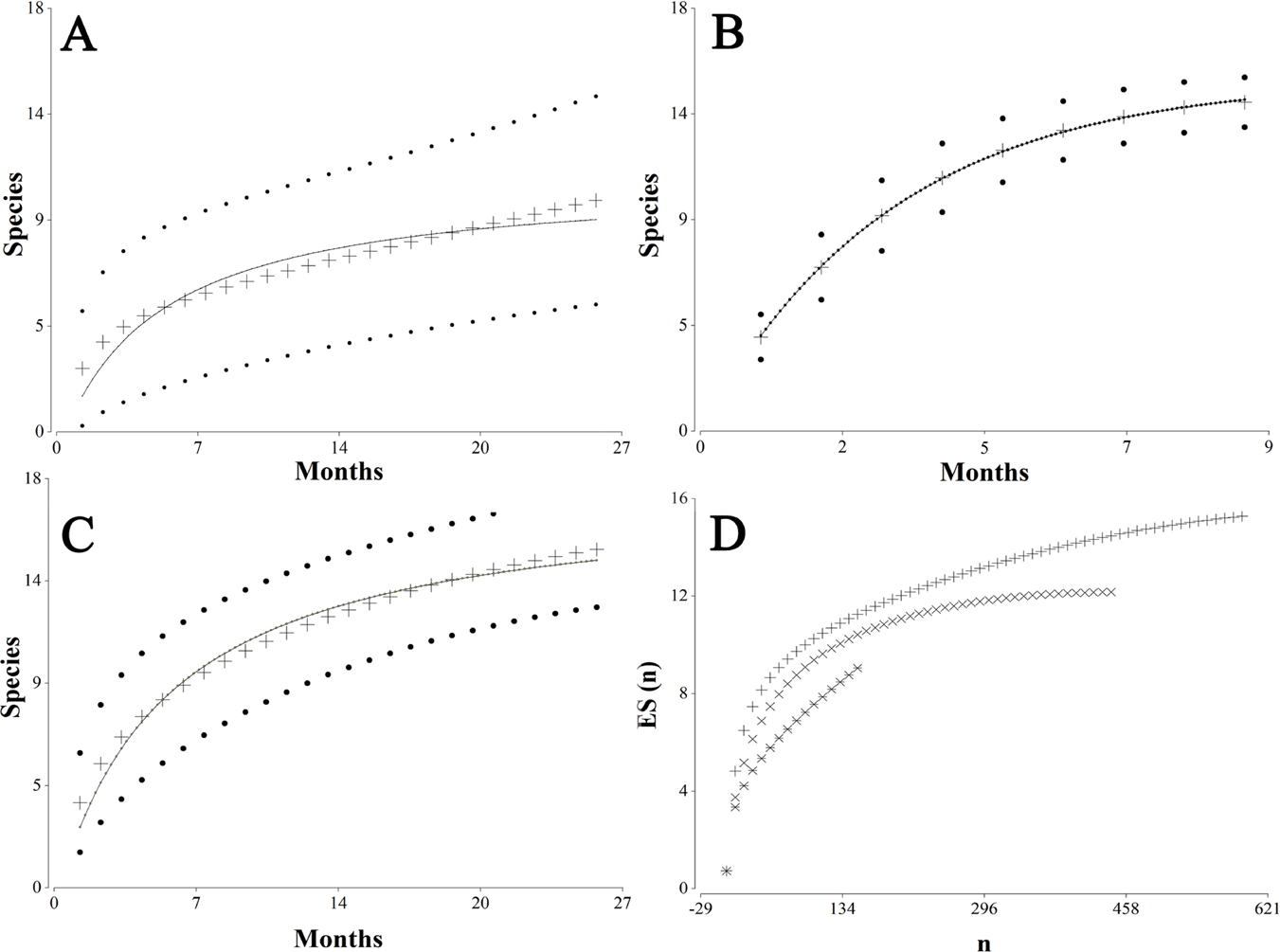
Figure 2 Species accumulation curve for (A) Camera-traps-CT, (B) Indirect records-IR and (C) combined methods and (D) rarefaction curves for the two methods (× = CT; +=IR) and combined (ӿ) for medium and large-sized terrestrial mammals detected at Tamá National Natural Park, Colombia.
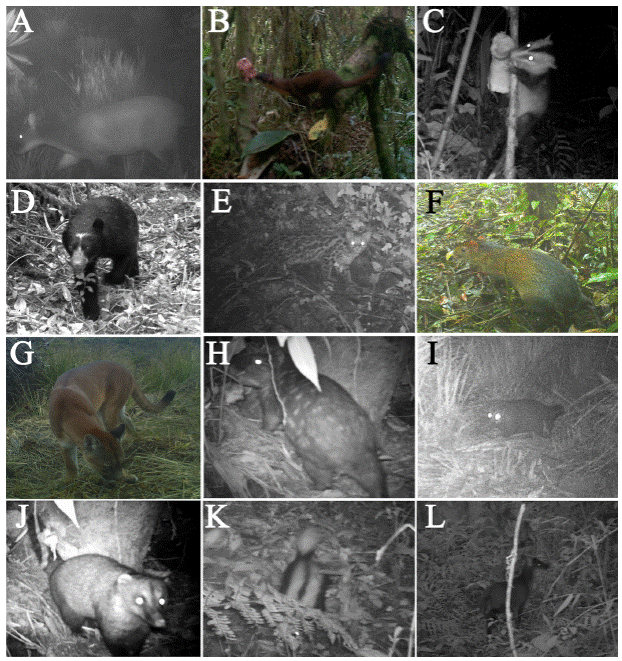
Figure 3 Species of medium and large-sized terrestrial mammals detected by camera traps at Tamá National Natural Park, Colombia: A) Mazama rufina, B) Mustela frenata, C) Didelphis pernigra, D) Tremarctos ornatus, E) Leopardus wiedii, F) Dasyprocta punctata, G) Puma concolor, H) Cuniculus taczanowskii, I) Nasua nasua, J) Nasuella olivacea, K) Conepatus semistriatus and L) Mazama rufina.
Table 1 Medium and large-sized terrestrial mammals recorded at Tamá National Natural Park, Colombia. Methods: CT: Camera-trap, IR: Indirect Record, DO: Direct Observation and I: Interview. Conservation status: NT: Near Threatened, LC: Least Concern, VU: Vulnerable. MCNUP-M: Museo de Historia Natural Universidad de Pamplona-Mamíferos.
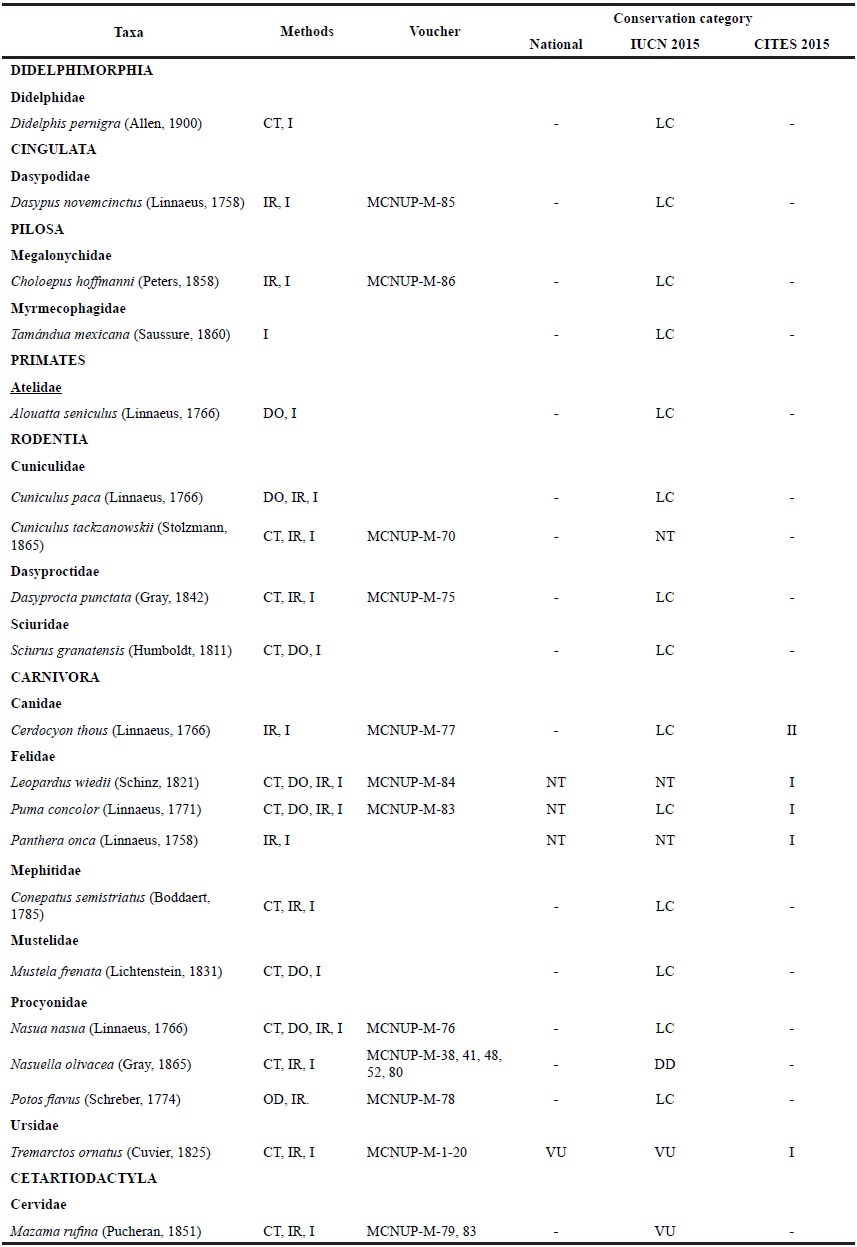
We estimated species' accumulation curves for each method (i. e., Camera-traps and Indirect records) and their combination, adjusting to three predefined models (Clench, Lineal Dependence and Logarithmic), and estimated rarefaction curves also for the three datasets using software EstimateS v. 9 (Espinosa 2003; Colwell 2013) and R environment (R Core Team 2013).
Results
We recorded 21 species of medium- and large-sized mammals distributed in 8 orders, 16 families and 21 genera (Table 1). Our species accumulation curve indicated a significant completeness of the indirect record surveys (0.89) but not as high for the camera-traps method (0.59). The combination of methods resulted on a good accumulation (0.85; Figure 2). Comparison of methods according to richness indicated the combination of survey methods accounted for a larger richness, followed by camera-traps and Indirect records (Figure 2).
We obtained a total of 40,068 photographs comprising 12 species of medium- and large-sized mammals (Figure 3, Table 2), of which 6 % (2,423) of the photographs were wild mammals and 7.2 % corresponded to introduced species such as domestic cattle and domestic dogs (Table 2), while 87 % of the pictures corresponded to false positives, mostly due to vegetation movement and direct light. The most frequently detected (i. e., capture rate CR) species were Nasua nasua (CR = 18 ind/100 trap-nights), Didelphis pernigra (CR = 16.4), and Cuniculus taczanowskii (CR = 13.3), while species such as Leopardus wiedii (CR = 1.6), Sciurus granatensis (CR = 2.3), and Conepatus semistriatus (CR = 1.6), were the least frequent (Table 2). Activity patterns showed a dominant nocturnal activity for the entire assemblage (K = 70.74, P < 0.001), as also found for most of the species excepting D. punctata, S. granatensis and M. frenata, while species such as P. concolor and N. nasua showed cathemeral activity (Figure 4). Activity patterns mean (± SD) overlapping among all species was low (0.13 ± 0.16). The species pairs with the highest overlap values were C. taczanowskii and N. nasua (0.67), M. frenata and T. ornatus (0.55) and D. punctata and S. granatensis (0.52; Figure 5 A).
Table 2 Activity period, Kuiper test estimator (*indicates significant differences from homogeneity P < 0.001), number of re- cords and capture rate from camera traps for medium and large-sized terrestrial mammals recorded at Tamá National Natural Park, Colombia.
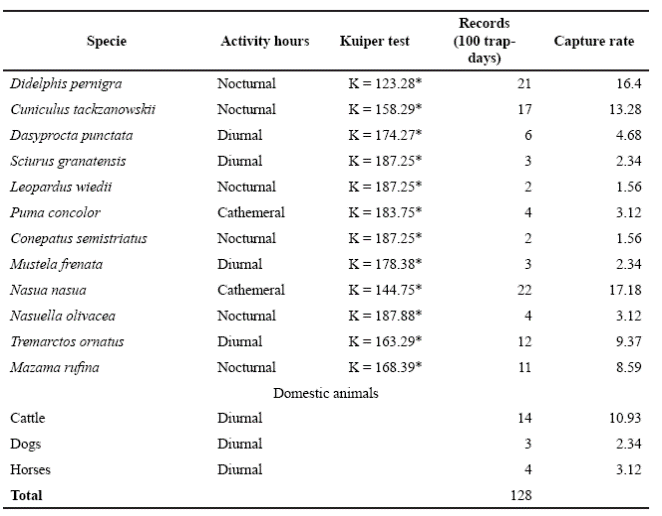
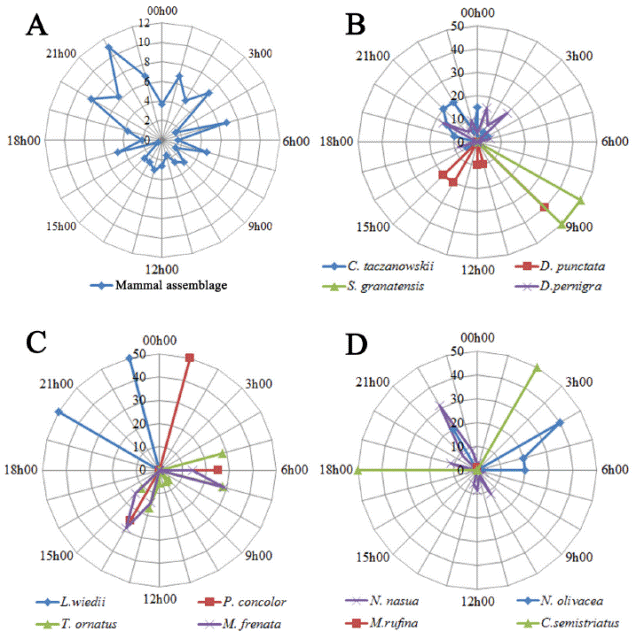
Figure 4 Activity patters of (A) all mammals, (B) Rodents and marsupials, (C) Felidae, Ursidae and Mustelidae and (D) Procyonidae, Cervidae and Mephitidae.
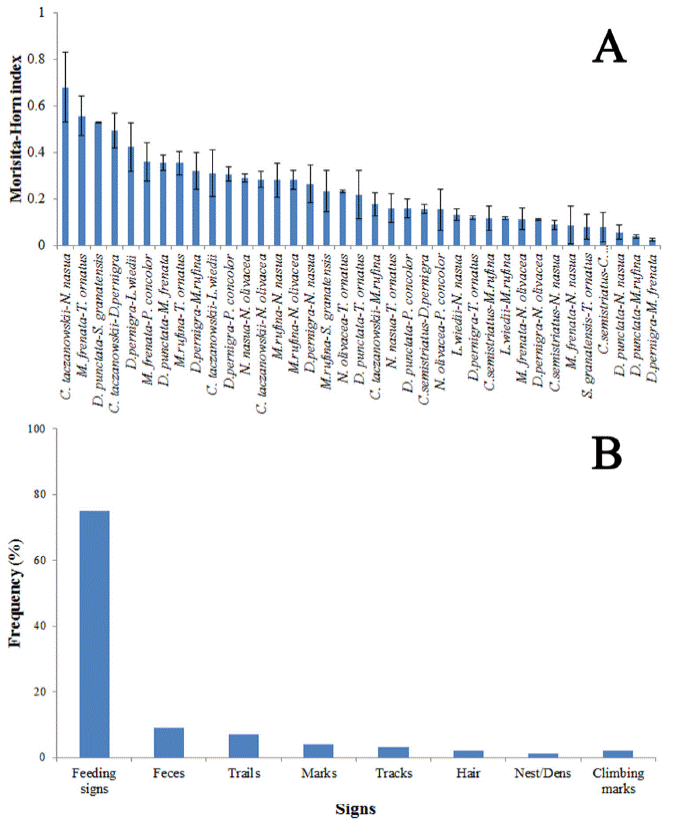
Figure 5 A) Morisita-Horn (SE) overlapping index among pair-wise species activity patterns comparisons and (B) frequency of indirect signs of medium and large-sized terrestrial mammals recorded at Tamá National Natural Park, Colombia.
We also obtained 3,278 indirect records, both from transects and opportunistic observations, of which the most abundant were feeding signs (2,471; 75.4 %) followed by feces (287; 8.7 %), while the least common were nests/dens (21; 0.6 %), and climbing marks (46; 1.4 %; Figure 5 B). Four species were identified from skeletal remains and/ or partially consumed carcasses preyed by Tremarctos ornatus, Puma concolor, and Leopardus wiedii: which included N. olivacea, Potus flavus, and Mazama rufina. Also, in 287 feces of these species, we detected remains of Cuniculus taczanowskii, N. olivacea, N. nasua, M. rufina, Dasyprocta punctata, C. paca, Dasypus novemcinctus, and Choloepus hoffmanni.
Nine species were directly observed and that were possible to identify on the field: P. concolor, Alouatta seniculus, Mustela frenata, Leopardus wiedii, Sciurus granatensis, N. nasua, P. flavus and C. paca. From corroborated information derived from interviews, we obtained material (i. e., photographs and animals parts from hunters) and evidence of presence and harvest of 20 species (Table 1, Figure 6). Some small mammals were also occasionally observed or detected (e.g., Cryptotis tamensis), but are not included in this report.
Discussion
This study constitutes the first estimate of the medium- and large-sized mammals' species richness from Tamá NNP and surrounding buffer areas. Although the number of species recorded could be considered low, given the extensive sampling effort we consider it a good first approach to mammal diversity in the area (Lira-Torres and Briones-Salas 2012). The confirmed presence of large species in the park, currently considered threatened for most the country (Rodríguez-Mahecha et al. 2006), highlight the importance of Tamá NNP and the La Carpa y La Rochela buffer zones for wild mammal conservation in the country. Interviews and anecdotal records indicate that historically the area has, and continue to, experience intensive hunting, which may have caused a dramatic decline in many mammal populations and may suggest that some species, such as T. ornatus, are much more threatened than currently thought in Northeastern Colombia (García-Rangel 2012; Caceres-Martinez and Acevedo 2014). Furthermore, many areas of the park were not surveyed given the armed conflict that still affects the area, especially in the lowlands. Other potentially present species, such as Tayassu pecari, Puma yagouaroundi, and Lontra longicaudis, were not recorded but are likely present in the park, which was also suggested by park rangers and local hunters. Our approach of using different survey methods is likely appropriate given that only with the two survey methods we obtained a reliable inventory of medium and large-sized mammals for the park (Sánchez et al. 2004; Norris et al. 2012). Nevertheless, a more geographically extensive survey design would likely register other species, and would provide more insights into distribution and habitat use in the area.
M. rufina was considered absent from the eastern mountain range and still its northern distribution is not well known (Lizcano and Alvarez 2008), while M. bricenii is presumed to occur in northern Colombia in areas such as Tamá NNP (Lizcano et al. 2010). The classification and identification of M. bricenii and M. rufina have been subject to recent debate (e. g., Solari et al. 2013; Gutiérrez et al. 2015), however, according to available descriptions for both species (Barrio 2010; Gutiérrez et al. 2015), and taxon validity (Gutiérrez et al. 2015), our records correspond to M. rufina. We therefore obtained multiple records of M. rufina between 350 and 3,450 m, in areas of tropical forest and Páramo (i. e., Páramo del Tamá and Páramo de Santa Isabel) near the border with Venezuela, indicating that the species is mostly nocturnal and solitary, adding some lights on the scarce knowledge of this species ecology (Lizcano and Alvarez 2008; Merino and Rossi 2010).
Several species were mainly diurnal, as previously reported for T. ornatus, M. frenata, D. punctata, and S. granatensis (Smythe 1978; Castellanos et al. 2005; Jiménez et al. 2010; Zapata-Ríos and Branch 2016) as were domestic and feral species such as dogs, cattle and horses (See Table 2); however, most species (M. rufina, D. pernigra, N. olivacea, C. semistriatus, L. wiedii, and C. taczanowskii) were found to be more active at night consistent with previous reports (Lizcano and Alvarez 2008; González-Maya et al. 2009; Jiménez et al. 2010; Zapata-Ríos and Branch 2016), and only few species were cathemeral (i. e., N. nasua and P. concolor). Preliminary data from our study indicate activity patterns of predators like P. concolor are partially concordant with the activity peaks of potential prey species (e.g., D. pernigra), which also was supported by overlapping of these species on the same localities, as previously reported for similar areas (Mosquera-Muñoz et al. 2014). Only weak overlapping was found however for main predators, likely reducing the likelihood of competition for prey-species (Jaksié et al. 1981). It is noteworthy that weak overlapping occurred among most species, although habitat use for almost the entire assemblage tended to be nocturnal. It is also important to highlight that this weak overlapping can be the result of scarce records for many species, thus having an effect derived from the small sample size (Blake et al. 2012). Although few studies exist for activity patterns in similar ecosystems, thus not allowing comparisons (Rust 1962; Richter and Schauber 2006), previous works on the subject have shown significant variation in activity patterns of most species due to presence of domestic animals (Zapata-Ríos and Branch 2016). Previous studies report that the presence of these animals, especially feral dogs, can turn most of the assemblage towards more nocturnal predominance (Zapata-Ríos and Branch 2016), which may be one of the causes for dominant nocturnal activities reflected in our data. However, more precise occupancy estimates could shed more lights on these patterns in the area, especially for species such as M. rufina and T. ornatus (Pérez- Irineo and Santos-Moreno 2013).
Lack of knowledge of the medium- and large-sized mammals at local and regional levels is a serious shortcoming that can lead to the disappearance and/or local extinction of many species, especially large predators such as T. ornatus, P. concolor, and Panthera onca due to their small populations, large space requirements and the many threats they face (Kattan et al. 2004; Rabinowitz and Zeller 2010; García-Rangel 2012; Caceres-Martinez and Acevedo 2014; Pizarro 2015) in absence of appropriate conservation planning (O'Brien 2008), even when an area is actively managed for conservation. Moreover, significant extents of Andean forests and Páramos in La Carpa and La Rochela, within the buffer zone, are not currently included in the official NNP limits. Our results indicate the presence of large species such as T. ornatus and P. concolor in these areas, being both critical for the connection with protected Páramos (e. g., La Cabrera and Tamá) and to the Venezuelan park, thus highlighting the need for expanding the park limits to include these areas. Although these areas are under park management, still there are many threats such as hunting, deforestation and conflict that still operate in these areas given the lack of enforcement, especially when it still occurs within the official portions of the Tamá NNP.
Threats such as illegal hunting are still considerably high in the region with potential significant impacts on medium and large mammals (Caceres-Martinez and Acevedo 2014). In addition, the advance of agriculture practices and land use transformation is also evident in the area, which together with hunting imposes a more severe threat to mammal populations. Considering the importance of this protected area, these threats need to be urgently controlled given the important mammal diversity the area still comprises (Woodman 2002; Armenteras et al. 2003; Caceres-Martinez and Acevedo 2014; Cáceres-Martínez et al. 2015). We expect this first effort of documenting mammal diversity in the park will contribute to the management and conservation of this important protected area of Colombia. Further efforts, however, should focus on assessing the conservation status and ecology of these populations together with providing more tools for the appropriate management and planning of the park.











 nova página do texto(beta)
nova página do texto(beta)


